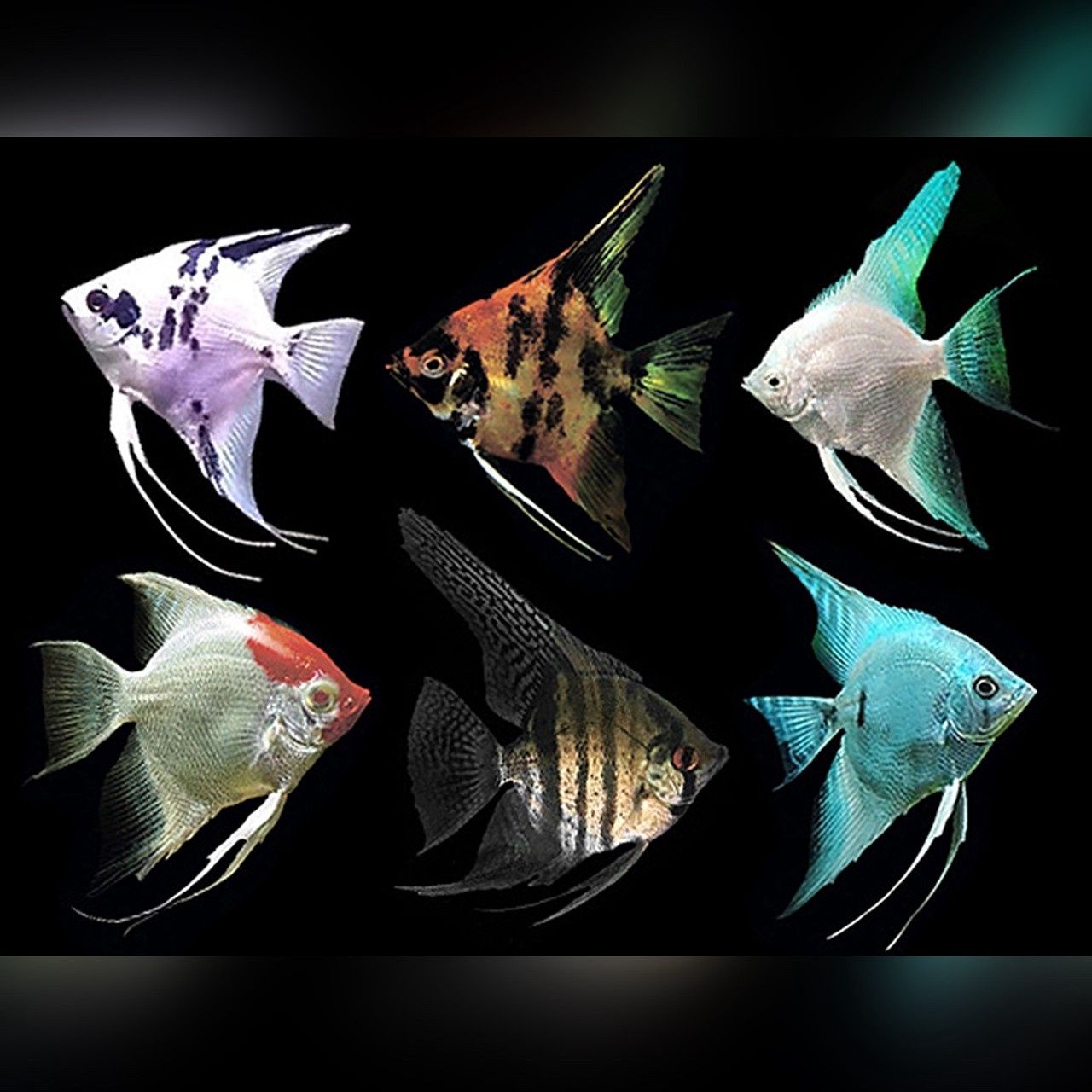Assorted Angelfish (Small)
R75.00
In stock
Save this product for later
Assorted Angelfish (Small)
Product Details
Assorted Angelfish are a popular group of freshwater aquarium fish that belong to the species Pterophyllum scalare. These fish are widely recognized for their elegant, triangular bodies, long flowing fins, and graceful swimming style. "Assorted Angelfish" is a general term used by aquarium retailers to describe various color and fin variations of the angelfish species, as angelfish come in many different colors and patterns.
Key Characteristics of Assorted Angelfish:
-
Appearance:
- Angelfish are known for their elegant appearance, featuring a diamond-shaped body, long pectoral fins, and tall dorsal and anal fins. They are laterally compressed (flattened from side to side), giving them their distinctive silhouette.
- The "assorted" designation means that you’ll often find a mix of colors and patterns, including gold, silver, black, marbled, koi, blushing, and striped varieties.
- The colors and patterns are determined by breeding and can vary widely, so you might see a mix of solid colors, marbled patterns, or fish with a combination of color bands and spots.
-
Size:
- Assorted Angelfish can grow quite large, with some individuals reaching 6 inches (15 cm) in body length and having fins that can extend to 8–12 inches (20–30 cm), including their long fins.
- They are one of the larger species of freshwater fish that thrive in home aquariums.
-
Lifespan:
- With proper care, Angelfish can live for about 5–10 years, sometimes even longer in ideal conditions.
Care Tips for Assorted Angelfish:
-
Tank Size:
- Due to their larger size and the fact that they can grow quite tall, Assorted Angelfish require a minimum tank size of 20 gallons for a single fish. If keeping a pair or multiple fish, a tank of at least 30 gallons is recommended.
- The tank should provide enough swimming space for their tall bodies, so a tall aquarium is preferred.
-
Water Parameters:
- Temperature: Angelfish are tropical fish and thrive in warm water, with an ideal temperature range of 75–82°F (24–28°C).
- pH: They prefer slightly acidic to neutral water, with a pH range of 6.5–7.5.
- Hardness: They do well in soft to moderately hard water, with hardness levels between 3–8 dGH.
- Water Quality: Like many tropical fish, Angelfish are sensitive to poor water conditions, so regular water changes and good filtration are essential for keeping them healthy. They prefer clean, well-oxygenated water with minimal ammonia, nitrites, and nitrates.
-
Diet:
- Angelfish are omnivores, and their diet should include a mix of high-quality flake food, pellets, and frozen or live foods such as brine shrimp, bloodworms, daphnia, and mysis shrimp.
- They also enjoy plant-based foods, so blanched vegetables like zucchini, spinach, or peas can be added to their diet to provide extra nutrition.
- It’s important to feed them a varied diet to ensure they receive all the necessary nutrients.
-
Tankmates:
- Assorted Angelfish are peaceful to semi-aggressive, but their temperament can vary depending on their individual personality and tank setup. They are generally fine in community tanks as long as they are not kept with very small fish or overly aggressive species.
- Suitable tankmates include tetras, corydoras catfish, rasboras, livebearers, and other non-aggressive species. Avoid keeping them with small fish that they might view as food, as well as aggressive or territorial fish.
- Angelfish can be territorial, especially during breeding, so it’s important to ensure there is plenty of space and hiding spots for all fish in the tank.
-
Aquascaping:
- Angelfish do well in a well-planted aquarium with plenty of vertical space for swimming. Plants such as Java Fern, Anubias, Cryptocorynes, and Vallisneria provide cover and help mimic their natural environment.
- You can also use driftwood and rocks to create hiding spots and territories, which is especially useful if you have multiple Angelfish or other fish in the tank.
-
Breeding:
- Angelfish are relatively easy to breed in the aquarium, especially if you have a well-established pair. They typically prefer slightly acidic water and a higher temperature to breed.
- They will spawn on flat surfaces such as leaves, rocks, or aquarium glass. The female lays eggs, and the male fertilizes them. Both parents often guard the eggs and the newly hatched fry.
- The fry are free-swimming after a few days, and you can feed them infusoria or liquid fry food until they grow large enough to eat baby brine shrimp.
Interesting Facts about Assorted Angelfish:
-
Native Habitat:
- Angelfish are native to the Amazon River Basin in South America. They are typically found in slow-moving waters such as rivers, lakes, and swamps, where they live among dense vegetation.
-
Color and Pattern Variations:
- Assorted Angelfish come in a wide variety of colors and patterns due to selective breeding. Common types include wild-type, gold, marbled, koi, blushing, and even blue or leopard-patterned varieties.
- The genetic diversity of Angelfish has resulted in a range of stunning patterns and colors, making them a beautiful centerpiece in any aquarium.
-
Territorial:
- While Angelfish are generally peaceful, they can become territorial during breeding. It’s not uncommon for a pair to defend a section of the tank, especially if there are eggs or fry. Providing plenty of space and hiding spots helps to reduce aggression.
-
Social Fish:
- Angelfish are social creatures, and while they can be kept in pairs, they also do well in groups. Keeping them in a group of 3 or more can encourage natural social behavior and reduce stress.
-
Long Fins:
- One of the most attractive features of Angelfish is their long, flowing fins, which give them an elegant, almost majestic appearance as they swim gracefully through the water.
Fun Fact:
- The Angelfish gets its name from its graceful, angelic appearance as they glide through the water, their long fins resembling angel wings. Their elegant swimming style has made them a favorite among aquarium enthusiasts for decades.
PLEASE NOTE: All pictures shown are for illustration purpose only. Actual fish may vary depending on size and variety of species.
Display prices in:ZAR

